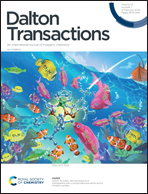Polyoxometalate/s-triazine hybrid heterostructures with ultrafast photochromic properties†
Abstract
As an emerging class of hybrid complexes, donor–acceptor (D–A) hybrid heterostructures, which combine the advantages of both organic and inorganic photoactive components, provide excellent platforms for the fabrication of photochromic materials with enhanced photo-responsive performances. Herein, four novel hybrid heterostructures, namely H3TPT·(PW12O40)·2NMP (1), (H1.5TPT)2·(PW12O40) (2), (H3TPT)2·(SiW12O40)·2Cl·2MeCN (3), and H3TPT·(HPMo12O40)·Cl·3NMP (4) (TPT is tri(4-pyridyl)-s-triazine, NMP is N-methylpyrrolidone), have been synthesized and characterized. Benefitting from the strong interactions (anion–π interactions) and matching electron energy levels between the donors and acceptors, some of them exhibited ultrafast photochromic behaviour even up to 1 second. Furthermore, based on experimental and theoretical calculations, the plausible PIET process and structure–activity relationship have been discussed in detail.



 Please wait while we load your content...
Please wait while we load your content...